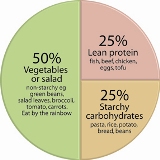- Home
- Blog
- Family and Feeding Kids
- Balanced dinners - how to get the proportions right
Balanced dinners - how to get the proportions right
Written by Catherine Saxelby
on Tuesday, 17 August 2010.
Tagged: balanced diet, diet, dinner, guides, healthy cooking, healthy eating, meal planning, portion size

These days, with supersize portions, large dinner plates and eat-as-much-as-you-can buffets, it's hard to judge the right proportions to dish out for the family's dinner. When serving dinner, how much protein, carbohydrate and veggies should you put on each plate?
Here's my easy guide - which I've nicknamed the 50:25:25 Dinner Rule. Use these proportions to create a balanced meat-plus-veg meal that's filling and nutritious.
1. Vegetables or salad 50%
 First fill 50 per cent of your dinner plate with non-starchy vegetables such as zucchini, green beans, broccoli, cabbage, asparagus, tomato or Asian greens.
First fill 50 per cent of your dinner plate with non-starchy vegetables such as zucchini, green beans, broccoli, cabbage, asparagus, tomato or Asian greens.
I tend not to worry about the carbohydrate in carrots or green peas or corn niblets - yes there's a little but they're so liked by kids, widely available and pad out the other greens.
If you're having a side salad with a grill, prepare a big salad and throw whatever you have hanging around the bottom of the crisper in with the salad leaves. It all works! And fills you up for few kilojoules/calories. A drizzle of oil-lemon dressing is fine in my opinion, as it adds healthy fats and improves the absorption of fat-soluble vitamins into your body. Just don't drown the salad in it!
Eat by the rainbow and choose vegetables with lots of different colours - greens, yellows, oranges, reds and browns. Your mother or grandmother had it right if they told you to balance your dinner with "one green, one orange and one white vegetable". Old-fashioned advice but still good!
2. Protein 25%
Next fill 25 per cent of the plate with the lean protein such as red meat, poultry or fish. Go for fat-trimmed beef, lamb or pork, veal, skinless chicken or turkey or fish.
3. Starchy carbs 25%
Fill the final 25 per cent with starchy carbohydrates such as pasta, noodles, rice, potato, beans or bread. The healthiest carbs are either wholegrain (brown rice, wholegrain bread) or low GI (sweet potato, pasta, lentils, chick peas).
How much meat is right?
One handy rule of thumb for meat is to use the palm your hand. Look at your palm - you should eat a piece of meat or chicken that matches the size of your palm.
- So for small-framed people, that equates to a steak that weighs anywhere from 120 g to 150 grams raw weight.
- For larger bodies, it may be as high as 15 g or 200 g.
- For white fish which is lighter and low in fat, you can eat more - choose a piece that's as big as your whole hand weighing in around 225 or 250 g.
This works best when you have three distinct pieces of food, say a grilled steak with a baked jacket potato and a side of leafy greens. But you can still make it work with a chicken and veg stir-fry with rice or pasta with lamb strips and Italian veges. Just think of each element - veg + protein + starch - in the 50:25:25 Rule.
......................................................................................................................................
Foodwatch
The Good Stuff
The Boring Stuff
© 2025 Foodwatch Australia. All rights reserved
Website by Joomstore eCommerce




